Project Management Plan for Levi Jeans: MBA642 Course Report
VerifiedAdded on 2022/08/14
|11
|2909
|9
Report
AI Summary
This report provides a comprehensive analysis of the project management failure of Levi Strauss's 'Silvertab' jeans, examining the reasons behind its market underperformance. It delves into the application of the IPECC (Initiating, Planning, Executing, Controlling, Closing) model, offering a detailed project management plan to revitalize the product and achieve success. The report emphasizes critical success factors, including effective communication, team motivation, and quality standards, tailored specifically to the Levi Jeans case. It explores the importance of market analysis, customer demand, and the need for quality management to meet customer expectations. The report uses the case study to illustrate the importance of adapting project management strategies to ensure product success and maintain brand reputation within a competitive market. The report also highlights the importance of quality control and strategic planning to align with the brand's heritage and customer preferences.

Running head: PROJECT MANAGEMENT
MBA642: Project Initiation, Planning and Execution
Name of the Student
Name of the University
Author’s Note
MBA642: Project Initiation, Planning and Execution
Name of the Student
Name of the University
Author’s Note
Paraphrase This Document
Need a fresh take? Get an instant paraphrase of this document with our AI Paraphraser
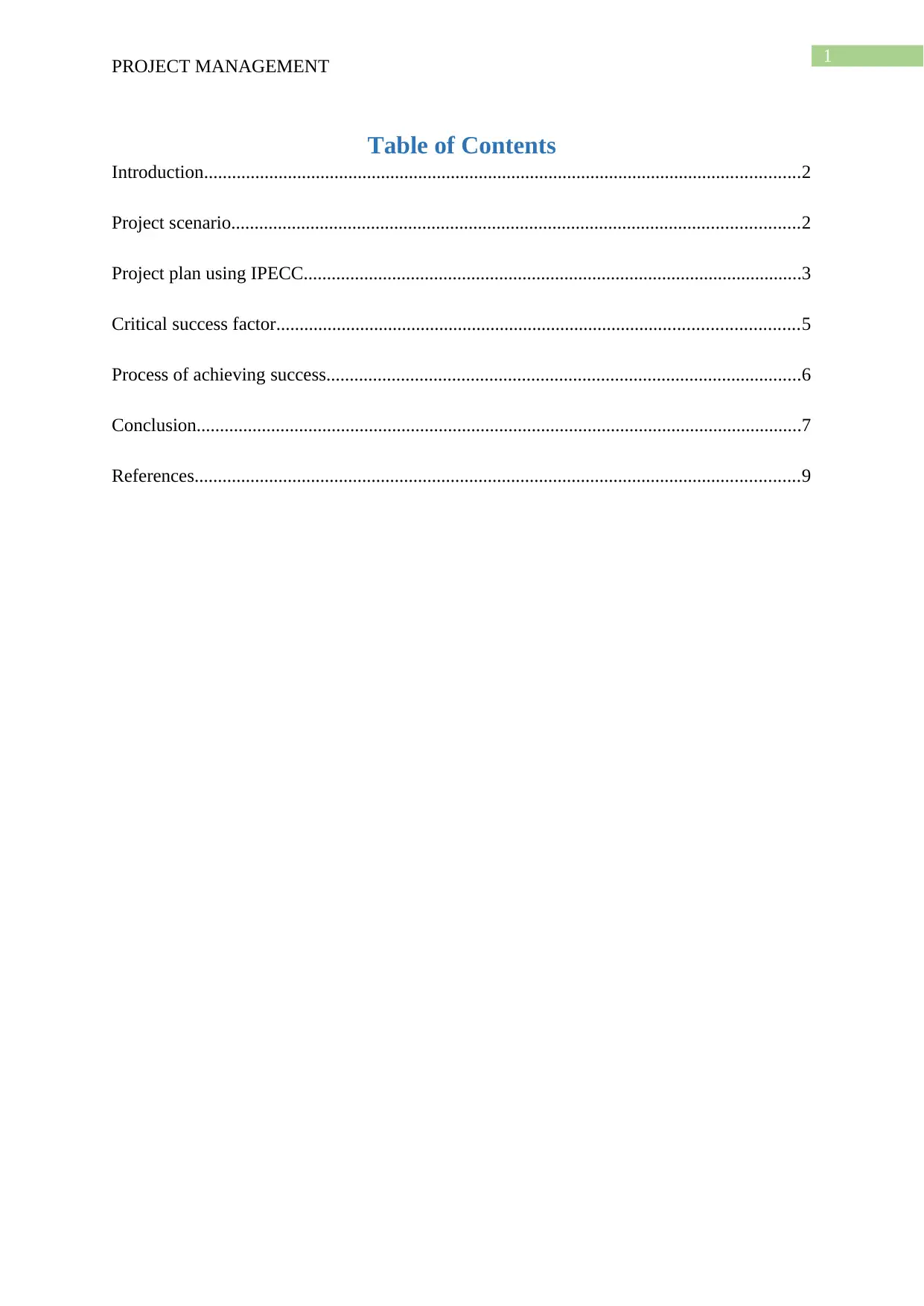
1
PROJECT MANAGEMENT
Table of Contents
Introduction................................................................................................................................2
Project scenario..........................................................................................................................2
Project plan using IPECC...........................................................................................................3
Critical success factor................................................................................................................5
Process of achieving success......................................................................................................6
Conclusion..................................................................................................................................7
References..................................................................................................................................9
PROJECT MANAGEMENT
Table of Contents
Introduction................................................................................................................................2
Project scenario..........................................................................................................................2
Project plan using IPECC...........................................................................................................3
Critical success factor................................................................................................................5
Process of achieving success......................................................................................................6
Conclusion..................................................................................................................................7
References..................................................................................................................................9

2
PROJECT MANAGEMENT
Introduction
The project management is measured as an important approach applicable for any
type of company for reaching to the success point due to having proper planning or execution
ideas (Kottorp et al. 2019). Within the project management, it embraces multiple steps to
complete any project of any company including initiation, planning execution, controlling
and also conclusion. Moreover, this project management also contains such critical success
factors which helps to reach to the company at the success point.
As per this report, it relates with the failure scenario of Levi’s jeans. The Levi is
referred as a reputed company for producing traditional jeans over the world. The secret of
happening of reputation of this company for maintaining both ubiquity as well as uniqueness.
The company of Levi has faced some of the issues regarding their launching of the new
products (Kerzner 2017). They actually produce the products of ‘red label’ which is
considered as the traditional jeans. But thinking for the brand growth and create a competitive
market, they have produced a product of ‘Silvertab’. But in the selling project of this product,
the company has challenged some issues and they do not reach at the success points of this
project. Thus, this report includes such project management related approach or inclusion of
such success factors which help them to reach at the success point.
Project scenario
This project involves a problematic situation of Levi’s company which creates due to
the production of new products of ‘Silvertab’. Generally the company of Levi is popular for
making of its traditional jeans of ‘Red label’ (Meredith, Mantel Jr and Shafer 2017). The
reputation of this company stands on the factors of ubiquity as well as uniqueness. According
to the growth of the competitive edge, the competition arises within the market due to coming
various equivalent companies. For that, the Levi Company have decided that they needs to
PROJECT MANAGEMENT
Introduction
The project management is measured as an important approach applicable for any
type of company for reaching to the success point due to having proper planning or execution
ideas (Kottorp et al. 2019). Within the project management, it embraces multiple steps to
complete any project of any company including initiation, planning execution, controlling
and also conclusion. Moreover, this project management also contains such critical success
factors which helps to reach to the company at the success point.
As per this report, it relates with the failure scenario of Levi’s jeans. The Levi is
referred as a reputed company for producing traditional jeans over the world. The secret of
happening of reputation of this company for maintaining both ubiquity as well as uniqueness.
The company of Levi has faced some of the issues regarding their launching of the new
products (Kerzner 2017). They actually produce the products of ‘red label’ which is
considered as the traditional jeans. But thinking for the brand growth and create a competitive
market, they have produced a product of ‘Silvertab’. But in the selling project of this product,
the company has challenged some issues and they do not reach at the success points of this
project. Thus, this report includes such project management related approach or inclusion of
such success factors which help them to reach at the success point.
Project scenario
This project involves a problematic situation of Levi’s company which creates due to
the production of new products of ‘Silvertab’. Generally the company of Levi is popular for
making of its traditional jeans of ‘Red label’ (Meredith, Mantel Jr and Shafer 2017). The
reputation of this company stands on the factors of ubiquity as well as uniqueness. According
to the growth of the competitive edge, the competition arises within the market due to coming
various equivalent companies. For that, the Levi Company have decided that they needs to
⊘ This is a preview!⊘
Do you want full access?
Subscribe today to unlock all pages.

Trusted by 1+ million students worldwide
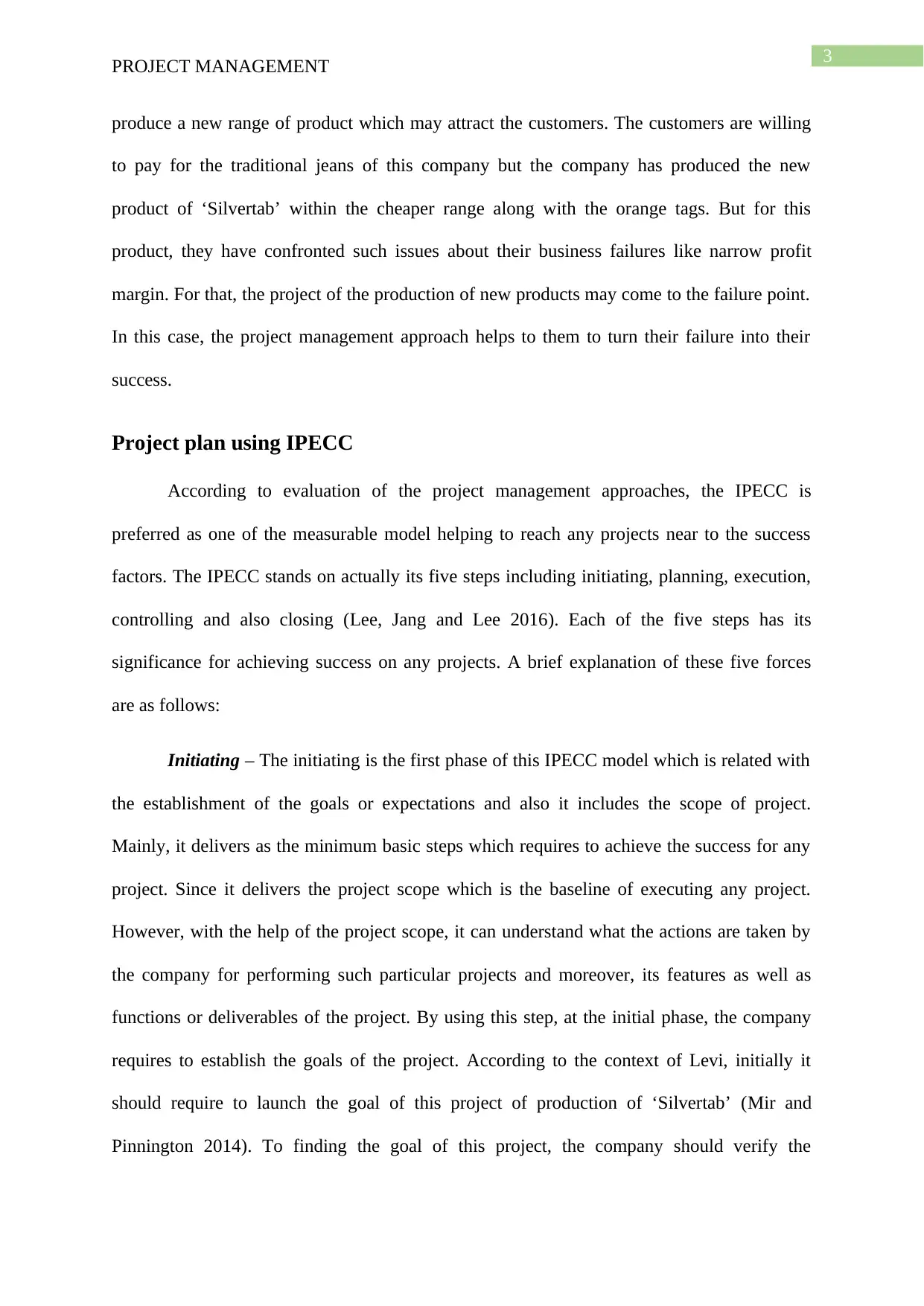
3
PROJECT MANAGEMENT
produce a new range of product which may attract the customers. The customers are willing
to pay for the traditional jeans of this company but the company has produced the new
product of ‘Silvertab’ within the cheaper range along with the orange tags. But for this
product, they have confronted such issues about their business failures like narrow profit
margin. For that, the project of the production of new products may come to the failure point.
In this case, the project management approach helps to them to turn their failure into their
success.
Project plan using IPECC
According to evaluation of the project management approaches, the IPECC is
preferred as one of the measurable model helping to reach any projects near to the success
factors. The IPECC stands on actually its five steps including initiating, planning, execution,
controlling and also closing (Lee, Jang and Lee 2016). Each of the five steps has its
significance for achieving success on any projects. A brief explanation of these five forces
are as follows:
Initiating – The initiating is the first phase of this IPECC model which is related with
the establishment of the goals or expectations and also it includes the scope of project.
Mainly, it delivers as the minimum basic steps which requires to achieve the success for any
project. Since it delivers the project scope which is the baseline of executing any project.
However, with the help of the project scope, it can understand what the actions are taken by
the company for performing such particular projects and moreover, its features as well as
functions or deliverables of the project. By using this step, at the initial phase, the company
requires to establish the goals of the project. According to the context of Levi, initially it
should require to launch the goal of this project of production of ‘Silvertab’ (Mir and
Pinnington 2014). To finding the goal of this project, the company should verify the
PROJECT MANAGEMENT
produce a new range of product which may attract the customers. The customers are willing
to pay for the traditional jeans of this company but the company has produced the new
product of ‘Silvertab’ within the cheaper range along with the orange tags. But for this
product, they have confronted such issues about their business failures like narrow profit
margin. For that, the project of the production of new products may come to the failure point.
In this case, the project management approach helps to them to turn their failure into their
success.
Project plan using IPECC
According to evaluation of the project management approaches, the IPECC is
preferred as one of the measurable model helping to reach any projects near to the success
factors. The IPECC stands on actually its five steps including initiating, planning, execution,
controlling and also closing (Lee, Jang and Lee 2016). Each of the five steps has its
significance for achieving success on any projects. A brief explanation of these five forces
are as follows:
Initiating – The initiating is the first phase of this IPECC model which is related with
the establishment of the goals or expectations and also it includes the scope of project.
Mainly, it delivers as the minimum basic steps which requires to achieve the success for any
project. Since it delivers the project scope which is the baseline of executing any project.
However, with the help of the project scope, it can understand what the actions are taken by
the company for performing such particular projects and moreover, its features as well as
functions or deliverables of the project. By using this step, at the initial phase, the company
requires to establish the goals of the project. According to the context of Levi, initially it
should require to launch the goal of this project of production of ‘Silvertab’ (Mir and
Pinnington 2014). To finding the goal of this project, the company should verify the
Paraphrase This Document
Need a fresh take? Get an instant paraphrase of this document with our AI Paraphraser
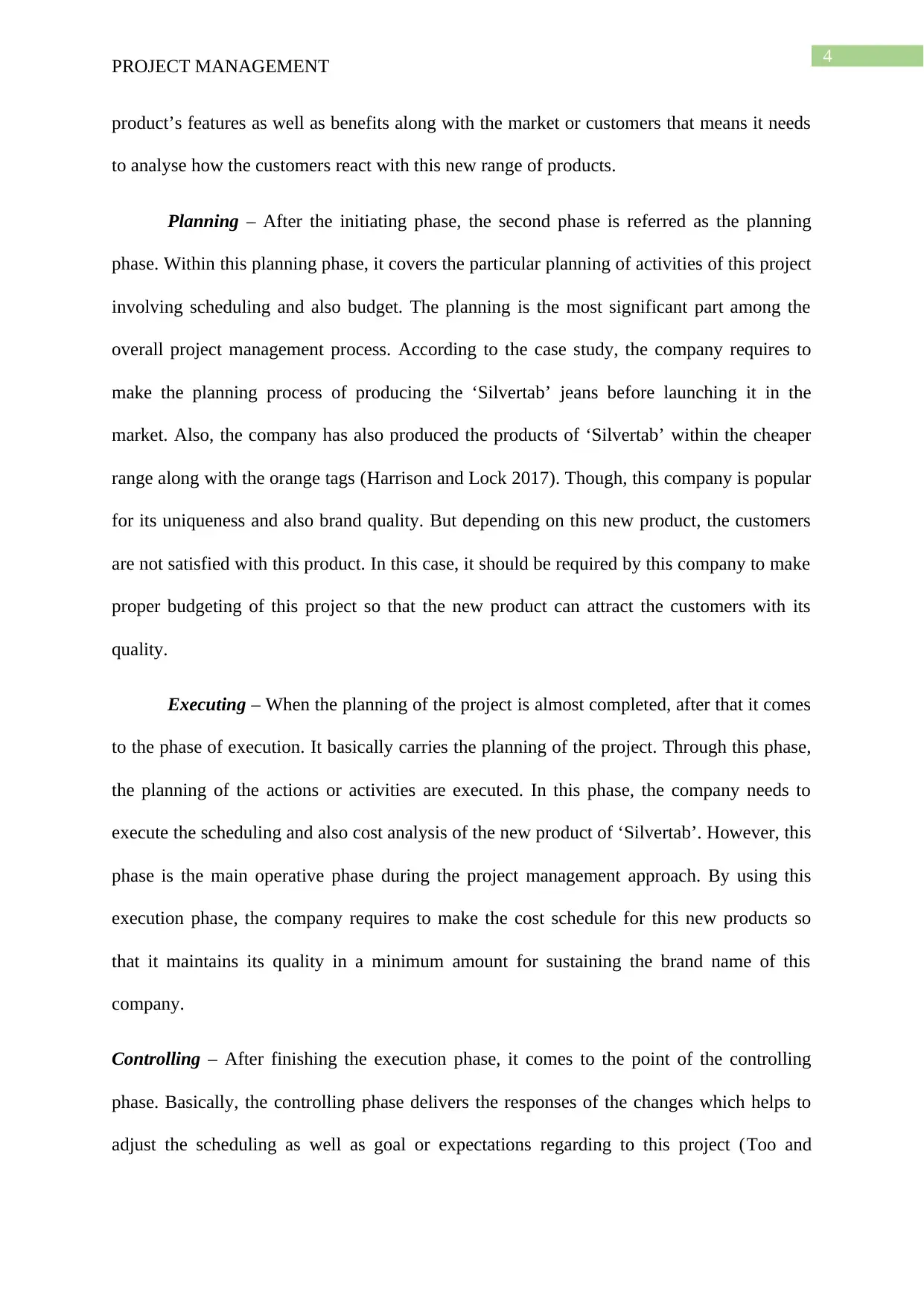
4
PROJECT MANAGEMENT
product’s features as well as benefits along with the market or customers that means it needs
to analyse how the customers react with this new range of products.
Planning – After the initiating phase, the second phase is referred as the planning
phase. Within this planning phase, it covers the particular planning of activities of this project
involving scheduling and also budget. The planning is the most significant part among the
overall project management process. According to the case study, the company requires to
make the planning process of producing the ‘Silvertab’ jeans before launching it in the
market. Also, the company has also produced the products of ‘Silvertab’ within the cheaper
range along with the orange tags (Harrison and Lock 2017). Though, this company is popular
for its uniqueness and also brand quality. But depending on this new product, the customers
are not satisfied with this product. In this case, it should be required by this company to make
proper budgeting of this project so that the new product can attract the customers with its
quality.
Executing – When the planning of the project is almost completed, after that it comes
to the phase of execution. It basically carries the planning of the project. Through this phase,
the planning of the actions or activities are executed. In this phase, the company needs to
execute the scheduling and also cost analysis of the new product of ‘Silvertab’. However, this
phase is the main operative phase during the project management approach. By using this
execution phase, the company requires to make the cost schedule for this new products so
that it maintains its quality in a minimum amount for sustaining the brand name of this
company.
Controlling – After finishing the execution phase, it comes to the point of the controlling
phase. Basically, the controlling phase delivers the responses of the changes which helps to
adjust the scheduling as well as goal or expectations regarding to this project (Too and
PROJECT MANAGEMENT
product’s features as well as benefits along with the market or customers that means it needs
to analyse how the customers react with this new range of products.
Planning – After the initiating phase, the second phase is referred as the planning
phase. Within this planning phase, it covers the particular planning of activities of this project
involving scheduling and also budget. The planning is the most significant part among the
overall project management process. According to the case study, the company requires to
make the planning process of producing the ‘Silvertab’ jeans before launching it in the
market. Also, the company has also produced the products of ‘Silvertab’ within the cheaper
range along with the orange tags (Harrison and Lock 2017). Though, this company is popular
for its uniqueness and also brand quality. But depending on this new product, the customers
are not satisfied with this product. In this case, it should be required by this company to make
proper budgeting of this project so that the new product can attract the customers with its
quality.
Executing – When the planning of the project is almost completed, after that it comes
to the phase of execution. It basically carries the planning of the project. Through this phase,
the planning of the actions or activities are executed. In this phase, the company needs to
execute the scheduling and also cost analysis of the new product of ‘Silvertab’. However, this
phase is the main operative phase during the project management approach. By using this
execution phase, the company requires to make the cost schedule for this new products so
that it maintains its quality in a minimum amount for sustaining the brand name of this
company.
Controlling – After finishing the execution phase, it comes to the point of the controlling
phase. Basically, the controlling phase delivers the responses of the changes which helps to
adjust the scheduling as well as goal or expectations regarding to this project (Too and
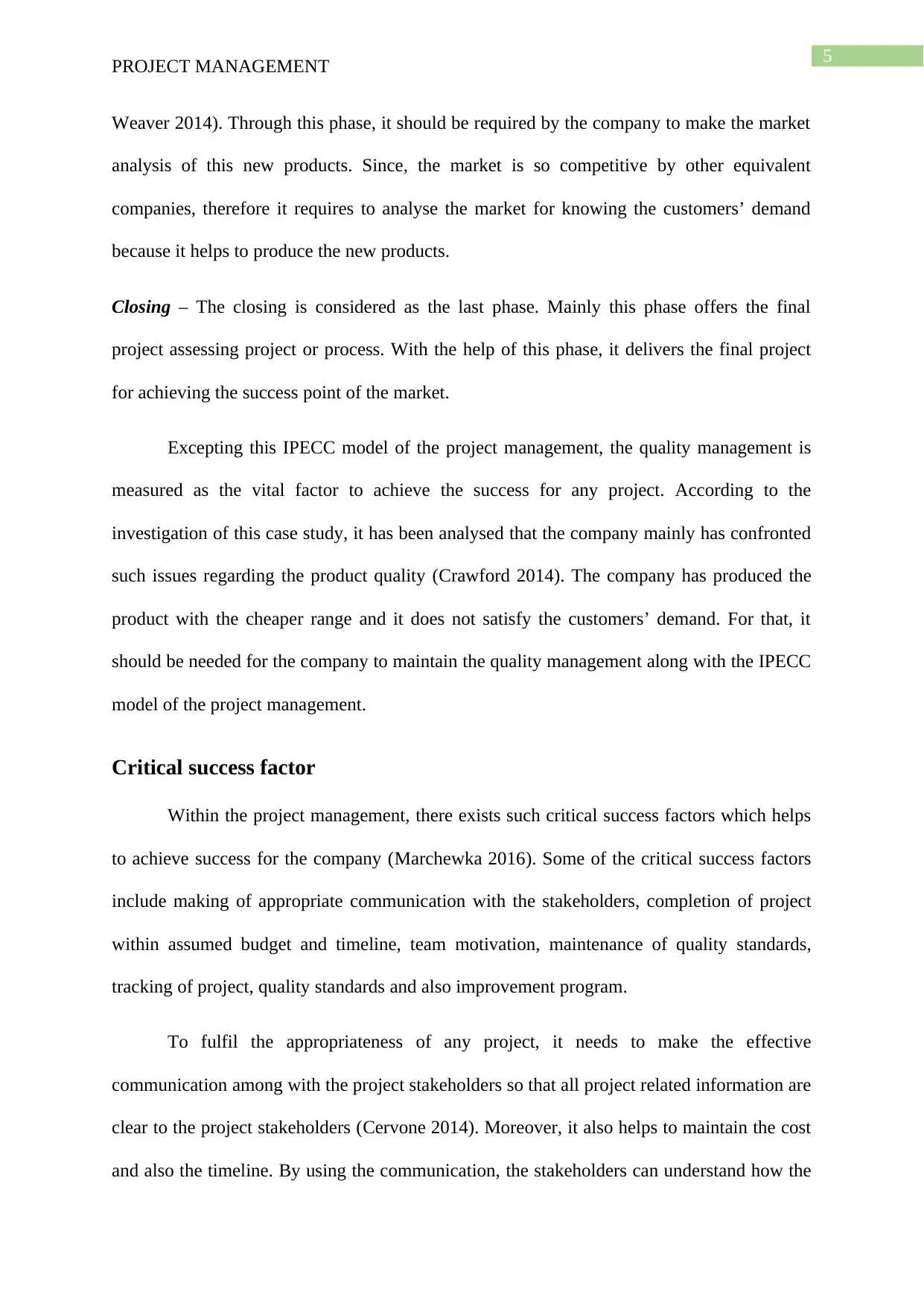
5
PROJECT MANAGEMENT
Weaver 2014). Through this phase, it should be required by the company to make the market
analysis of this new products. Since, the market is so competitive by other equivalent
companies, therefore it requires to analyse the market for knowing the customers’ demand
because it helps to produce the new products.
Closing – The closing is considered as the last phase. Mainly this phase offers the final
project assessing project or process. With the help of this phase, it delivers the final project
for achieving the success point of the market.
Excepting this IPECC model of the project management, the quality management is
measured as the vital factor to achieve the success for any project. According to the
investigation of this case study, it has been analysed that the company mainly has confronted
such issues regarding the product quality (Crawford 2014). The company has produced the
product with the cheaper range and it does not satisfy the customers’ demand. For that, it
should be needed for the company to maintain the quality management along with the IPECC
model of the project management.
Critical success factor
Within the project management, there exists such critical success factors which helps
to achieve success for the company (Marchewka 2016). Some of the critical success factors
include making of appropriate communication with the stakeholders, completion of project
within assumed budget and timeline, team motivation, maintenance of quality standards,
tracking of project, quality standards and also improvement program.
To fulfil the appropriateness of any project, it needs to make the effective
communication among with the project stakeholders so that all project related information are
clear to the project stakeholders (Cervone 2014). Moreover, it also helps to maintain the cost
and also the timeline. By using the communication, the stakeholders can understand how the
PROJECT MANAGEMENT
Weaver 2014). Through this phase, it should be required by the company to make the market
analysis of this new products. Since, the market is so competitive by other equivalent
companies, therefore it requires to analyse the market for knowing the customers’ demand
because it helps to produce the new products.
Closing – The closing is considered as the last phase. Mainly this phase offers the final
project assessing project or process. With the help of this phase, it delivers the final project
for achieving the success point of the market.
Excepting this IPECC model of the project management, the quality management is
measured as the vital factor to achieve the success for any project. According to the
investigation of this case study, it has been analysed that the company mainly has confronted
such issues regarding the product quality (Crawford 2014). The company has produced the
product with the cheaper range and it does not satisfy the customers’ demand. For that, it
should be needed for the company to maintain the quality management along with the IPECC
model of the project management.
Critical success factor
Within the project management, there exists such critical success factors which helps
to achieve success for the company (Marchewka 2016). Some of the critical success factors
include making of appropriate communication with the stakeholders, completion of project
within assumed budget and timeline, team motivation, maintenance of quality standards,
tracking of project, quality standards and also improvement program.
To fulfil the appropriateness of any project, it needs to make the effective
communication among with the project stakeholders so that all project related information are
clear to the project stakeholders (Cervone 2014). Moreover, it also helps to maintain the cost
and also the timeline. By using the communication, the stakeholders can understand how the
⊘ This is a preview!⊘
Do you want full access?
Subscribe today to unlock all pages.

Trusted by 1+ million students worldwide
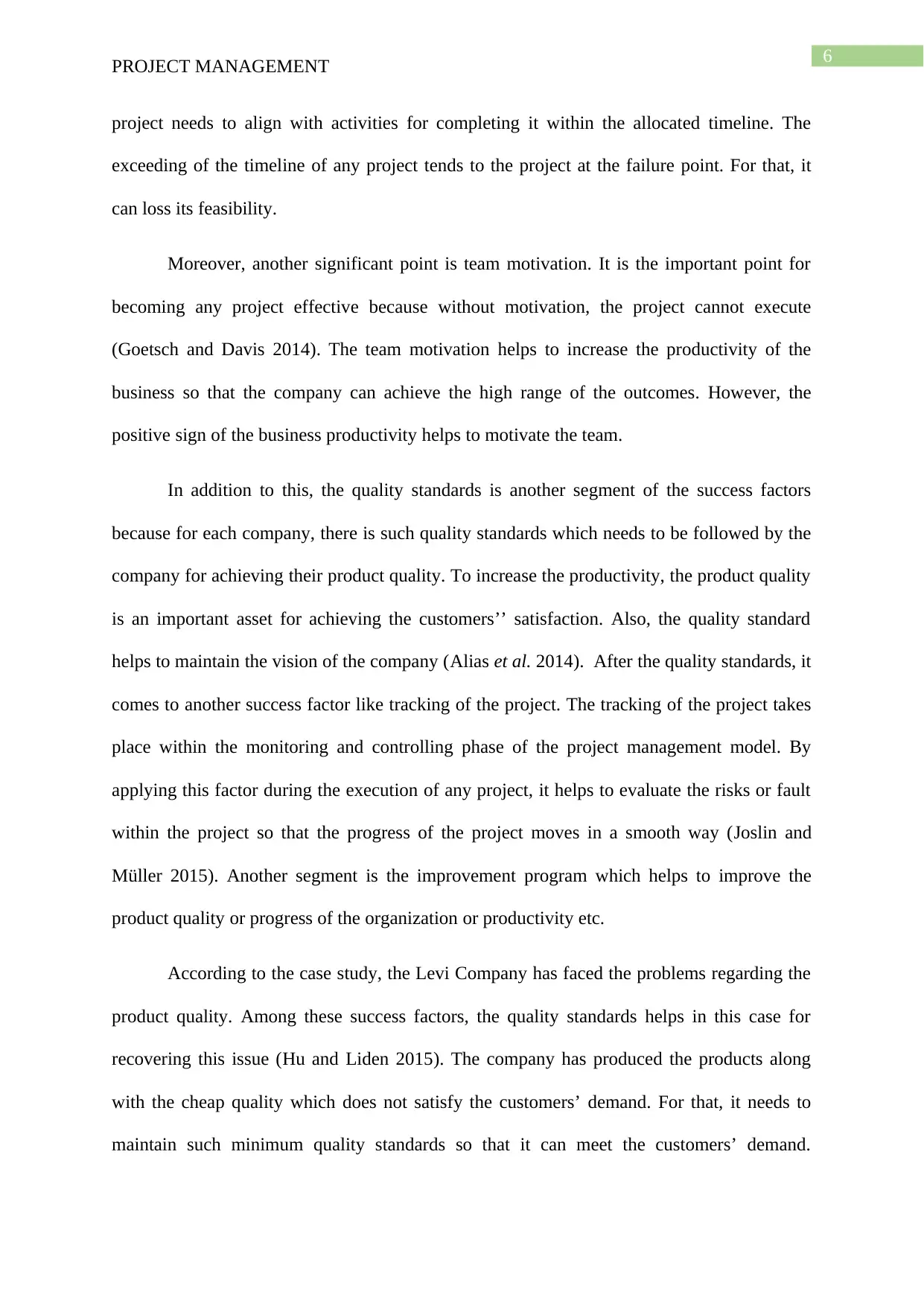
6
PROJECT MANAGEMENT
project needs to align with activities for completing it within the allocated timeline. The
exceeding of the timeline of any project tends to the project at the failure point. For that, it
can loss its feasibility.
Moreover, another significant point is team motivation. It is the important point for
becoming any project effective because without motivation, the project cannot execute
(Goetsch and Davis 2014). The team motivation helps to increase the productivity of the
business so that the company can achieve the high range of the outcomes. However, the
positive sign of the business productivity helps to motivate the team.
In addition to this, the quality standards is another segment of the success factors
because for each company, there is such quality standards which needs to be followed by the
company for achieving their product quality. To increase the productivity, the product quality
is an important asset for achieving the customers’’ satisfaction. Also, the quality standard
helps to maintain the vision of the company (Alias et al. 2014). After the quality standards, it
comes to another success factor like tracking of the project. The tracking of the project takes
place within the monitoring and controlling phase of the project management model. By
applying this factor during the execution of any project, it helps to evaluate the risks or fault
within the project so that the progress of the project moves in a smooth way (Joslin and
Müller 2015). Another segment is the improvement program which helps to improve the
product quality or progress of the organization or productivity etc.
According to the case study, the Levi Company has faced the problems regarding the
product quality. Among these success factors, the quality standards helps in this case for
recovering this issue (Hu and Liden 2015). The company has produced the products along
with the cheap quality which does not satisfy the customers’ demand. For that, it needs to
maintain such minimum quality standards so that it can meet the customers’ demand.
PROJECT MANAGEMENT
project needs to align with activities for completing it within the allocated timeline. The
exceeding of the timeline of any project tends to the project at the failure point. For that, it
can loss its feasibility.
Moreover, another significant point is team motivation. It is the important point for
becoming any project effective because without motivation, the project cannot execute
(Goetsch and Davis 2014). The team motivation helps to increase the productivity of the
business so that the company can achieve the high range of the outcomes. However, the
positive sign of the business productivity helps to motivate the team.
In addition to this, the quality standards is another segment of the success factors
because for each company, there is such quality standards which needs to be followed by the
company for achieving their product quality. To increase the productivity, the product quality
is an important asset for achieving the customers’’ satisfaction. Also, the quality standard
helps to maintain the vision of the company (Alias et al. 2014). After the quality standards, it
comes to another success factor like tracking of the project. The tracking of the project takes
place within the monitoring and controlling phase of the project management model. By
applying this factor during the execution of any project, it helps to evaluate the risks or fault
within the project so that the progress of the project moves in a smooth way (Joslin and
Müller 2015). Another segment is the improvement program which helps to improve the
product quality or progress of the organization or productivity etc.
According to the case study, the Levi Company has faced the problems regarding the
product quality. Among these success factors, the quality standards helps in this case for
recovering this issue (Hu and Liden 2015). The company has produced the products along
with the cheap quality which does not satisfy the customers’ demand. For that, it needs to
maintain such minimum quality standards so that it can meet the customers’ demand.
Paraphrase This Document
Need a fresh take? Get an instant paraphrase of this document with our AI Paraphraser

7
PROJECT MANAGEMENT
Moreover, for increasing the productivity, the quality carries its importance with a huge range
for producing the products along with the minimum quality. Thus, in this case, the quality
standard is utilized for achieving the success for this company.
Process of achieving success
The Levi Company is considered as popular company for producing the traditional
jeans. The company produced the traditional jeans of ‘Red label’ which satisfies the
customers’ demand. The customers like the company for its ubiquity as well as uniqueness.
Also, the quality is the important reason for liking the company. But the company has faced
such quality issues regarding the product of ‘Silvertab’. However, the company has produced
this product with the cheaper quality and follows the narrow profit margin. For that, it cannot
meet the customers’ demand (Wang, Kim and Lee 2016). Thus, the company has faced lots
of quality related issues which effects on the productivity of the business.
Based on the case study, the company needs to follow the IPECC model for achieving
the success for this business. However, the model along with its five stages help to the project
so effective step by step. Another factor also reflects on the productivity of this company and
this factor is quality standard which is considered as the critical success factor. The basics of
the quality standards allows the company for maintaining the quality for their products so that
they can able to meet the customers’ demand (Shields et al. 2018). However, the customers
of this company want to the best product quality and to maintain the trust with the customers,
it needs to follow the quality standards for achieving the success by increasing the production
efficiency.
Conclusion
The Levi Company has faced such issues regarding the product of ‘Silvertab’. The
company is popular for its ubiquity as well as uniqueness. To maintain the brand quality, it
PROJECT MANAGEMENT
Moreover, for increasing the productivity, the quality carries its importance with a huge range
for producing the products along with the minimum quality. Thus, in this case, the quality
standard is utilized for achieving the success for this company.
Process of achieving success
The Levi Company is considered as popular company for producing the traditional
jeans. The company produced the traditional jeans of ‘Red label’ which satisfies the
customers’ demand. The customers like the company for its ubiquity as well as uniqueness.
Also, the quality is the important reason for liking the company. But the company has faced
such quality issues regarding the product of ‘Silvertab’. However, the company has produced
this product with the cheaper quality and follows the narrow profit margin. For that, it cannot
meet the customers’ demand (Wang, Kim and Lee 2016). Thus, the company has faced lots
of quality related issues which effects on the productivity of the business.
Based on the case study, the company needs to follow the IPECC model for achieving
the success for this business. However, the model along with its five stages help to the project
so effective step by step. Another factor also reflects on the productivity of this company and
this factor is quality standard which is considered as the critical success factor. The basics of
the quality standards allows the company for maintaining the quality for their products so that
they can able to meet the customers’ demand (Shields et al. 2018). However, the customers
of this company want to the best product quality and to maintain the trust with the customers,
it needs to follow the quality standards for achieving the success by increasing the production
efficiency.
Conclusion
The Levi Company has faced such issues regarding the product of ‘Silvertab’. The
company is popular for its ubiquity as well as uniqueness. To maintain the brand quality, it

8
PROJECT MANAGEMENT
requires to satisfy the customers’ demand so that it can achieve the success of the company.
Within this report, it contains the project management approach of IPECC model for helping
the project in a right track. Moreover, the description part of this project allows such critical
success factors which helps to reach the project to the higher range of success. Within this
report, the success factors including the quality standard helps to the project for maintaining
the quality. However, based on the product quality, the productivity of the business depends.
Thus, it needs to maintain the basic level of quality standards so that they can achiever the
success by increasing the productivity.
PROJECT MANAGEMENT
requires to satisfy the customers’ demand so that it can achieve the success of the company.
Within this report, it contains the project management approach of IPECC model for helping
the project in a right track. Moreover, the description part of this project allows such critical
success factors which helps to reach the project to the higher range of success. Within this
report, the success factors including the quality standard helps to the project for maintaining
the quality. However, based on the product quality, the productivity of the business depends.
Thus, it needs to maintain the basic level of quality standards so that they can achiever the
success by increasing the productivity.
⊘ This is a preview!⊘
Do you want full access?
Subscribe today to unlock all pages.

Trusted by 1+ million students worldwide

9
PROJECT MANAGEMENT
References
Alias, Z., Zawawi, E.M.A., Yusof, K. and Aris, N.M., 2014. Determining critical success
factors of project management practice: A conceptual framework. Procedia-Social and
Behavioral Sciences, 153, pp.61-69.
Cervone, H.F., 2014. Effective communication for project success. OCLC Systems and
Services: International digital library perspectives.
Crawford, J.K., 2014. Project management maturity model. Auerbach Publications.
Goetsch, D.L. and Davis, S.B., 2014. Quality management for organizational excellence.
Upper Saddle River, NJ: pearson.
Harrison, F. and Lock, D., 2017. Advanced project management: a structured approach.
Routledge.
Hu, J. and Liden, R.C., 2015. Making a difference in the teamwork: Linking team prosocial
motivation to team processes and effectiveness. Academy of Management Journal, 58(4),
pp.1102-1127.
Joslin, R. and Müller, R., 2015. Relationships between a project management methodology
and project success in different project governance contexts. International journal of project
management, 33(6), pp.1377-1392.
Kerzner, H., 2017. Project management: a systems approach to planning, scheduling, and
controlling. John Wiley & Sons.
Kottorp, A., Keehn, M., Hasnain, M., Gruss, V. and Peterson, E., 2019. Instrument
Refinement for Measuring Self-Efficacy for Competence in Interprofessional Collaborative
PROJECT MANAGEMENT
References
Alias, Z., Zawawi, E.M.A., Yusof, K. and Aris, N.M., 2014. Determining critical success
factors of project management practice: A conceptual framework. Procedia-Social and
Behavioral Sciences, 153, pp.61-69.
Cervone, H.F., 2014. Effective communication for project success. OCLC Systems and
Services: International digital library perspectives.
Crawford, J.K., 2014. Project management maturity model. Auerbach Publications.
Goetsch, D.L. and Davis, S.B., 2014. Quality management for organizational excellence.
Upper Saddle River, NJ: pearson.
Harrison, F. and Lock, D., 2017. Advanced project management: a structured approach.
Routledge.
Hu, J. and Liden, R.C., 2015. Making a difference in the teamwork: Linking team prosocial
motivation to team processes and effectiveness. Academy of Management Journal, 58(4),
pp.1102-1127.
Joslin, R. and Müller, R., 2015. Relationships between a project management methodology
and project success in different project governance contexts. International journal of project
management, 33(6), pp.1377-1392.
Kerzner, H., 2017. Project management: a systems approach to planning, scheduling, and
controlling. John Wiley & Sons.
Kottorp, A., Keehn, M., Hasnain, M., Gruss, V. and Peterson, E., 2019. Instrument
Refinement for Measuring Self-Efficacy for Competence in Interprofessional Collaborative
Paraphrase This Document
Need a fresh take? Get an instant paraphrase of this document with our AI Paraphraser
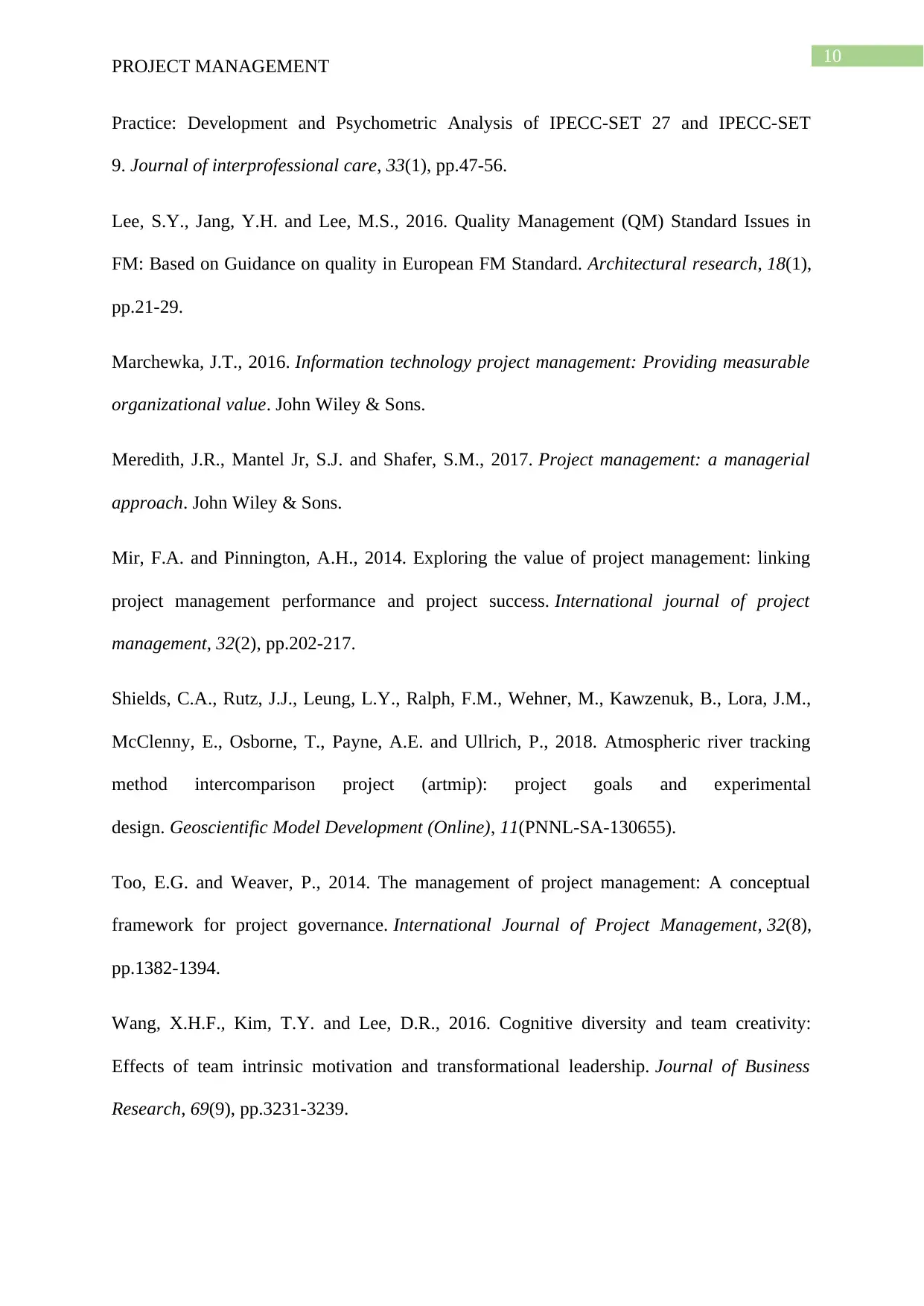
10
PROJECT MANAGEMENT
Practice: Development and Psychometric Analysis of IPECC-SET 27 and IPECC-SET
9. Journal of interprofessional care, 33(1), pp.47-56.
Lee, S.Y., Jang, Y.H. and Lee, M.S., 2016. Quality Management (QM) Standard Issues in
FM: Based on Guidance on quality in European FM Standard. Architectural research, 18(1),
pp.21-29.
Marchewka, J.T., 2016. Information technology project management: Providing measurable
organizational value. John Wiley & Sons.
Meredith, J.R., Mantel Jr, S.J. and Shafer, S.M., 2017. Project management: a managerial
approach. John Wiley & Sons.
Mir, F.A. and Pinnington, A.H., 2014. Exploring the value of project management: linking
project management performance and project success. International journal of project
management, 32(2), pp.202-217.
Shields, C.A., Rutz, J.J., Leung, L.Y., Ralph, F.M., Wehner, M., Kawzenuk, B., Lora, J.M.,
McClenny, E., Osborne, T., Payne, A.E. and Ullrich, P., 2018. Atmospheric river tracking
method intercomparison project (artmip): project goals and experimental
design. Geoscientific Model Development (Online), 11(PNNL-SA-130655).
Too, E.G. and Weaver, P., 2014. The management of project management: A conceptual
framework for project governance. International Journal of Project Management, 32(8),
pp.1382-1394.
Wang, X.H.F., Kim, T.Y. and Lee, D.R., 2016. Cognitive diversity and team creativity:
Effects of team intrinsic motivation and transformational leadership. Journal of Business
Research, 69(9), pp.3231-3239.
PROJECT MANAGEMENT
Practice: Development and Psychometric Analysis of IPECC-SET 27 and IPECC-SET
9. Journal of interprofessional care, 33(1), pp.47-56.
Lee, S.Y., Jang, Y.H. and Lee, M.S., 2016. Quality Management (QM) Standard Issues in
FM: Based on Guidance on quality in European FM Standard. Architectural research, 18(1),
pp.21-29.
Marchewka, J.T., 2016. Information technology project management: Providing measurable
organizational value. John Wiley & Sons.
Meredith, J.R., Mantel Jr, S.J. and Shafer, S.M., 2017. Project management: a managerial
approach. John Wiley & Sons.
Mir, F.A. and Pinnington, A.H., 2014. Exploring the value of project management: linking
project management performance and project success. International journal of project
management, 32(2), pp.202-217.
Shields, C.A., Rutz, J.J., Leung, L.Y., Ralph, F.M., Wehner, M., Kawzenuk, B., Lora, J.M.,
McClenny, E., Osborne, T., Payne, A.E. and Ullrich, P., 2018. Atmospheric river tracking
method intercomparison project (artmip): project goals and experimental
design. Geoscientific Model Development (Online), 11(PNNL-SA-130655).
Too, E.G. and Weaver, P., 2014. The management of project management: A conceptual
framework for project governance. International Journal of Project Management, 32(8),
pp.1382-1394.
Wang, X.H.F., Kim, T.Y. and Lee, D.R., 2016. Cognitive diversity and team creativity:
Effects of team intrinsic motivation and transformational leadership. Journal of Business
Research, 69(9), pp.3231-3239.
1 out of 11
Related Documents
Your All-in-One AI-Powered Toolkit for Academic Success.
+13062052269
info@desklib.com
Available 24*7 on WhatsApp / Email
![[object Object]](/_next/static/media/star-bottom.7253800d.svg)
Unlock your academic potential
Copyright © 2020–2025 A2Z Services. All Rights Reserved. Developed and managed by ZUCOL.





